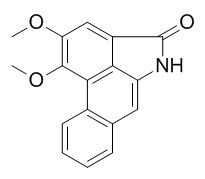Aristolactam BII
Aristolactam BII exhibits antimicrobial and antiinflammatory activity, it shows significant activity towards DPPH radical scavenging and potent inhibitory effects against tyrosinase mushroom. Aristolactam BII also exerts its significant neuroprotective effects on glutamate-injured primary cultures of rat cortical cells by directly inhibiting the production of nitric oxide.
Inquire / Order:
manager@chemfaces.com
Technical Inquiries:
service@chemfaces.com
Tel:
+86-27-84237783
Fax:
+86-27-84254680
Address:
1 Building, No. 83, CheCheng Rd., Wuhan Economic and Technological Development Zone, Wuhan, Hubei 430056, PRC
Providing storage is as stated on the product vial and the vial is kept tightly sealed, the product can be stored for up to
24 months(2-8C).
Wherever possible, you should prepare and use solutions on the same day. However, if you need to make up stock solutions in advance, we recommend that you store the solution as aliquots in tightly sealed vials at -20C. Generally, these will be useable for up to two weeks. Before use, and prior to opening the vial we recommend that you allow your product to equilibrate to room temperature for at least 1 hour.
Need more advice on solubility, usage and handling? Please email to: service@chemfaces.com
The packaging of the product may have turned upside down during transportation, resulting in the natural compounds adhering to the neck or cap of the vial. take the vial out of its packaging and gently shake to let the compounds fall to the bottom of the vial. for liquid products, centrifuge at 200-500 RPM to gather the liquid at the bottom of the vial. try to avoid loss or contamination during handling.
ACS Pharmacol. Transl. Sci.2023, 3c00129.
Antioxidants (Basel).2021, 10(10):1620.
ScientificWorldJournal.2022, 2022:4806889.
Molecules 2021, 26(4),1092.
Theranostics.2023, 13(9):3103-3116.
J Holistic Integrative Pharm.2023, 4(1):14-28
Molecules.2020, 25(23):5556.
Molecules.2017, 22(6)
J.of Traditional&Complementary Med.2022, 10.1016:j.jtcme.
Int J Mol Sci.2021, 22(11):5503.
Related and Featured Products
Planta Med. 2004 May;70(5):391-6.
Aristolactam BII of Saururus chinensis attenuates glutamate-induced neurotoxicity in rat cortical cultures probably by inhibiting nitric oxide production.[Pubmed:
15124081]
Saurolactam and Aristolactam BII, aristolactam-type alkaloids isolated from the aerial part of Saururus chinensis (Lour.) Ball (Saururaceae), showed significant neuroprotective activity against glutamate-induced toxicity in primary cultured rat cortical cells.
METHODS AND RESULTS:
The action mechanism of Aristolactam BII, the more potent neuroprotective compound, was investigated using primary cultures of rat cortical cells as an in vitro system. Aristolactam BII attenuated glutamate-induced neurotoxicity significantly when it was added immediately or up to 9 h after the excitotoxic glutamate challenge. The alkaloid could not protect cultured neuronal cells from neurotoxicity induced by kainic acid or N-methyl- D-aspartate in a pre-treatment paradigm. However, Aristolactam BII successfully reduced the overproduction of nitric oxide and the level of cellular peroxide in cultured neurons when it was treated as a post-treatment paradigm.
CONCLUSIONS:
These results may suggest that Aristolactam BII exerts its significant neuroprotective effects on glutamate-injured primary cultures of rat cortical cells by directly inhibiting the production of nitric oxide.
Nat Prod Commun. 2010 Feb;5(2):253-8.
Aristolactams, 1-(2-C-methyl-beta-D-ribofuranosyl)-uracil and other bioactive constituents of Toussaintia orientalis.[Pubmed:
20334138]
METHODS AND RESULTS:
The new aristolactam alkaloid toussalactam {2-hydroxy-1,6-dimethoxy-5H-dibenzo[cdf]indol-4-one} and the known ones, namely aristolactam AII, Aristolactam BII, piperolactam C and aristolactam FII; 1-(2-C-methyl-beta-D-ribofuranosyl)-uracil, 3,4,5-trimethoxyphenyl-beta-D-glucopyranoside, and three catechinoids were isolated from the cytotoxic Toussaintia orientalis Verdc stem and root bark extracts, and their structures established based on analysis of spectroscopic data.
CONCLUSIONS:
The aristolactams exhibited antimicrobial and antiinflammatory activity, aristolactam FII showing almost the same level of activity as the standard anti-inflammatory agent Indomethacin.
The compounds also exhibited either mild or no antiproliferative and cytotoxic activities, except aristolactam FII that showed the same level of cytotoxicity as the standard drug Camptothecin. 1-(2-C-Methyl-beta-D-ribofuranosyl)-uracil, which is being reported for the first time as a natural product, was inactive in the antibacterial, antifungal, antiinflammatory, antiproliferative and cytotoxicity assays.
J. Appl. Pharm. Sci., 2014, 4(5):87-91.
Antioxidant and Anti-tyrosinase Activities from Piper officinarum C.DC (Piperaceae).[Reference:
WebLink]
The present study was carried out to evaluate antioxidant and anti-tyrosinase activities from Piper officinarum stems, as well as investigation of its chemical constituents.
METHODS AND RESULTS:
In a series of in vitro assays, antioxidant (DPPH radical scavenging and total phenolic content) and anti-tyrosinase (mushroom tyrosinase) activities of various extracts of stem were evaluated. The isolation and purification of the constituents were carried out on the extracts using various chromatographic methods and identified by direct comparison of their spectroscopic data with respective published data. The results showed that the methanol extracts showed the highest DPPH (80.0%) at 1 mg/ml, as well as total phenolic content (50.5%). Phytochemical analysis of the stem extracts have isolated five compounds identified as 4-allyl resorcinol (1), aristolactam AII (2) Aristolactam BII (3), stigmast-4-en-3-one (4) and 6-hydroxystigmast-4-en-3-one (5). Compound (1), (2) and (3) showed significant activity towards DPPH radical scavenging (I%=17.3-28.1%), while (2), (3) and (4) demonstrated potent inhibitory effects against tyrosinase mushroom (I%=11.1-24.4%).
CONCLUSIONS:
The results showed that the stem extracts has significant antioxidant activity that may help to discover new chemical classes of natural antioxidant substances.
Nat Prod Res. 2012;26(19):1824-30.
A new conjugated amide-dimer from the aerial parts of Piper submultinerve.[Pubmed:
22117113 ]
METHODS AND RESULTS:
Bioassay-guided fractionation and purification of the aerial parts of Piper submultinerve led to the isolation of a new conjugated amide-dimer, submultinamide A (1), along with 11 known compounds. The structures were determined on the basis of spectroscopic methods.
CONCLUSIONS:
Among the tested compounds, pellitorine (2), guineensine (4), N-benzylcinnamide (6) and Aristolactam BII (8) showed significant activities in the anti-syncytium assay using (ΔTat/Rev)MC99 virus and 1A2 cell line system, whereas 2 was most active (EC₅₀ 35.1 µM and selectivity index 4.7). In the HIV-1 reverse transcriptase assay, only 4 was active with IC₅₀ 50.8 µM.



